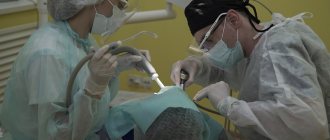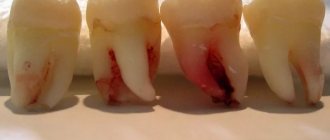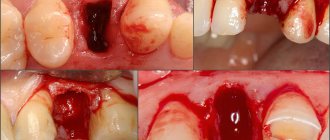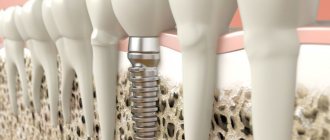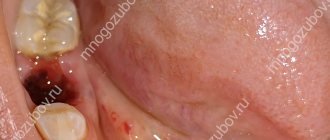Home → Articles → Recommendations after gum surgery
The dental team at the Stomatolog 11 clinic strongly advises that you follow all recommendations after gum surgery. Safe dental treatment using modern dental devices in the clinic creates conditions for a comfortable postoperative period. Maintain your oral health after surgery by following the tips below.
Sign up for a consultation at the dental clinic “Stomatolog11” in the Northern Administrative District:
Make an appointment
What is drainage
Gum drainage has been performed by surgeons for many decades. It is a tube made of dense materials and its role in the treatment of infectious diseases can hardly be overestimated.
The invention was invented by a surgeon from France, Chassagnac. To create the structure, the doctor used glass and rubber. With the help of such a device, doctors could remove excess fluid and remaining necrotic masses from inflamed tissues. To achieve the desired effect, doctors left the tubes in the patient's body for several days.
And nowadays, surgeons use drainage during operations. However, the appearance of the devices has undergone significant changes: the tubes have become smaller and thinner in size, and modern materials are used to create them. The external drainage has changed, but all its functions have been preserved. It does not allow the incision in the gum to close prematurely; promotes the rapid removal of pus, ichor and necrotic masses from the affected areas; Helps drugs reach deep layers of soft tissue.
What drainage in soft tissues looks like in the photo
The drainage is left in the mouth until the swelling subsides. This sign indicates complete cleansing of the affected area. For speedy wound regeneration in the postoperative period, it will be necessary to use special ointments, gels and solutions for rinsing the mouth.
To create modern drainages, latex and rubber materials are used. Due to this, the patient practically does not feel discomfort when eating. Waterproof materials are firmly held in the gums and do not allow the tissues to tighten. A small section of the tube remains on the outside of the gum. Through it, pus is removed unnoticed by the patient.
How to speed up gum healing after tooth extraction
The simplest and most effective technique that a dental surgeon can use to ensure fast and effective regeneration is suturing the socket. It is important to ensure that the edges of the mucous membranes are located as close to each other as possible. This will reduce the risk of secondary infection and create suitable conditions for trouble-free regeneration.
It is also very important that the patient strictly followed all medical prescriptions. The pharmacy offers a wide range of healing and anti-inflammatory ointments, gels, creams and solutions used in dentistry. But you don’t need to buy the first product that comes your way—the drug must be prescribed by a doctor.
It is very important not to touch the healing hole with your tongue or foreign objects. It is forbidden to touch the blood clot covering the wound. If you move it from its place, severe inflammation may occur. Then it will most likely not be possible to do without antibiotics.
When is the procedure scheduled?
Drainage is necessary to remove purulent contents after a gum incision or tooth extraction. The passage of pus through a rubber tube is called the drainage process.
The procedure has 2 main goals:
- complete elimination of purulent exudate;
- preventing gum healing.
Saliva contains special substances that stimulate the regeneration of damaged soft tissues. Because of this, pathogenic microorganisms can remain inside the gums without having time to come out along with the necrotic masses. The condition provokes repeated exacerbation of inflammatory processes. In addition, epithelial cells are characterized by rapid division, which also contributes to the rapid healing of the wound after gum excision.
Drainage is required in cases where purulent formations in the oral cavity have been removed - abscess, gumboil, phlegmon. In this case, the doctor cuts the gum and places a drainage
For complete release of exudate from the wound, it is necessary to slow down the healing of the epithelium. A tape or tube type device does not allow the edges of the wound to converge prematurely.
How long does the drainage last? The answer to this question can be given by the surgeon after assessing the condition of the gums in the postoperative period. The device is removed after signs of swelling and inflammation of the soft tissue disappear.
If the tube is removed prematurely or not installed at all, the exudate will spread to nearby tissues and subcutaneous fat. The condition can cause dangerous infectious complications that lead to health problems, even death.
How long does drainage last after a gum incision? On average, this period is 1-2 days. The period can be extended after removal of abscesses and phlegmons to 1 week. If an infectious-inflammatory disease is accompanied by fever, then usually after installation of drainage this symptom disappears within a few days.
The installation is used not only after a gum incision, but also after tooth removal. Extraction in the first few days is also dangerous for the development of infectious complications. Installing a drainage tube reduces the risk of negative consequences and prevents gum infection.
The scheme is also used to accelerate the delivery of drugs to the pathological focus. This method simplifies the treatment of soft tissues located in hard-to-reach areas.
Flux is one of the common complications after tooth extraction performed with gum cutting
If the first signs of an abscess or flux occur, you should immediately consult a doctor. The methods of modern dentistry allow you to quickly and painlessly cope with the problem, while traditional medicine and self-medication can only aggravate the course of the disease.
Contraindications
Dissection of soft tissues with further installation of drainage is not possible in all cases. Among the prohibitions to the procedure are:
- pathologies associated with blood clotting disorders;
- allergy to painkillers used before the procedure.
In the latter case, the doctor must select a drug that does not cause adverse reactions in the patient. There are no other contraindications to drainage. If the cheek is swollen, and necrotic masses have accumulated in the periodontal tissues, then the easiest way to deal with the problem is by installing drainage.
Stages of drainage
The procedure can only be performed by a specialist. Trimming the gums and installing a rubber tube occurs in several stages:
- Examination of the oral cavity by a dentist.
- Taking an x-ray to determine the depth of the tumor and the extent of its spread to adjacent tissues.
- Injection of an anesthetic into the problem area. Does it hurt to cut your gum? The procedure is accompanied by significant discomfort, so anesthesia is used to minimize pain.
- Resection of the seal using a scalpel.
- Cleaning the purulent cavity using antiseptic agents.
- Fixation of a rubber tube to drain pus.
Using an X-ray of the oral cavity, the doctor can examine the condition of the roots of the teeth and, if necessary, prescribe extraction of problematic units
In severe cases, the drainage is left in the oral cavity for 3-5 days, until the swelling subsides and the ichor stops oozing from the wound. The drain may fall out on its own or be removed by a doctor. If swelling and inflammation persist 5 days after the intervention, you should immediately contact your dentist.
Why does a wound take a long time to heal after tooth extraction?
Ripping out a destroyed unit is a very traumatic process. This operation is comparable to any other surgical procedure. The tissue surrounding the removed roots is severely damaged. The integrity of the periodontal and periodontal zones is compromised.
Microtears of ligaments and destruction of individual nerve bundles are observed. The injured area swells, turns blue, swells, and becomes painful to the touch. It is clear that in such a situation regeneration cannot be lightning fast. It should be understood that how long it takes for gums to recover depends on many factors:
- person's age;
- an illness that necessitated dental surgery;
- characteristics of the patient's health status;
- the presence of concomitant pathologies of a systemic nature in the patient;
- the complexity of the surgical procedures being performed;
- experience of a dental surgeon;
- the need for sutures;
- the number of roots in the tooth being pulled out;
- features of the location of the unit in the dentition.
What to do if the drainage falls out?
What to do if the implant falls out of the gums prematurely? The answer to the question depends on the characteristics of the clinical case. If the swelling has subsided and the patient is not bothered by pain, then there is no need to contact the clinic to re-install the device. You cannot remove drainage from the oral cavity on your own even if the problem signs have completely disappeared.
Among the reasons for the installation to fall out on its own, the following should be noted:
- active rinsing of the mouth and thorough brushing of teeth;
- improper fixation of the structure over the tooth.
Re-installation is required if the gums still hurt after the rubber tube falls out. It is better if the procedure for installing the system is carried out by a doctor in a clinic. Only in rare cases do specialists allow patients to remove the drainage themselves when signs of swelling and inflammation disappear.
Blister on the gum - what is it?
The procedure is carried out independently, taking into account the rules:
- Hands are washed thoroughly with soap.
- The oral cavity is treated with antiseptic solutions.
- The tape or tube is removed in front of a mirror. Grasp the free edge of the material with your thumb and index finger.
The procedure is accompanied by minor pain and blood loss. All of these signs are normal. You cannot interrupt treatment immediately after installing the tube.
The wound left after drainage should be regularly treated with antiseptics
How to rinse your mouth? Miramistin, Chlorhexidine solution, and hydrogen peroxide solution are suitable for this purpose. The procedure is necessary to prevent recurrence of the problem.
An abscess or gumboil is treated comprehensively. Pathology cannot be treated with medications alone. Therapy should include the installation of drainage, local treatment of the affected area and physiotherapeutic procedures carried out after opening the purulent focus.
Incision healing time
How long will it take for the gums to heal after drainage is removed from it? On average, tissue regeneration takes 1-2 weeks. The process largely depends on the complexity of the previous operation and the individual characteristics of the patient. For example, in older people, wounds take longer to heal. This fact is explained by the slowdown of metabolic processes with age.
Complete gum regeneration may take more than 6 months. The wound healing process after opening the abscess takes place in several stages:
- the formation of a blood clot that protects the wound from the introduction of pathogenic microorganisms;
- formation of new granulation tissue (within 3-4 days from the moment of intervention);
- maturation of new epithelium (7-10 days from the moment of opening of the purulent focus);
- soft tissue regeneration;
- formation of young bone tissue.
After the operation, the dentist gives the patient a number of instructions that help maintain drainage in the gums and avoid the development of complications after the intervention. In the first 3-4 hours after the procedure, it is prohibited to consume food. During treatment, it is advisable to redistribute the chewing load to the healthy side of the jaw. Doctors also advise giving preference to dietary products.
In the postoperative period, it is necessary to avoid intense physical activity and avoid visiting saunas, swimming pools and baths. It is also important to give up bad habits - smoking and drinking alcohol.
Complications after surgery
Complications of gum incisions include:
- fever, indicating current inflammation;
- swelling of the gums;
- boring, burning pain radiating to the jaw bone, ear;
- bleeding 1–2 hours after surgery;
- flux.
Self-medication here is dangerous, since any of the complications may require repeated incision of the gums.
Edema and swelling
Swelling at the wound site for 2–3 days is acceptable. If it spreads to the cheek, this may be a sign of alveolitis - inflammation of the socket, requiring repeated intervention.
Heat
With normal healing, the temperature gradually drops by day 4–5. If it lasts longer and becomes higher, the wound has become infected and a new operation is needed.
Pain
The pain gradually subsides. When it increases, the appearance of a new character, severity, coupled with swelling and high temperature, surgical treatment of a purulent infection is required.
Bleeding
When the gums are cut, bleeding occurs after 1–2 hours. Homemade hemostatic agents are used: hydrogen peroxide, applying a tampon to the wound. If the patient sees that the bleeding does not stop, urgent assistance from a dentist is needed.
Flux
With increased pain and swelling, inflammation can spread to the periosteum of the jaw, and gumboil occurs. Surgical treatment is needed.


